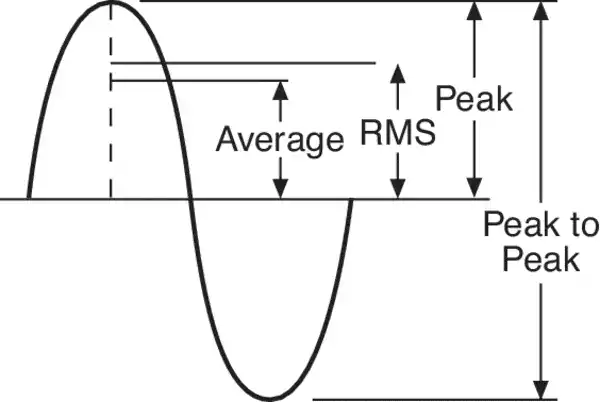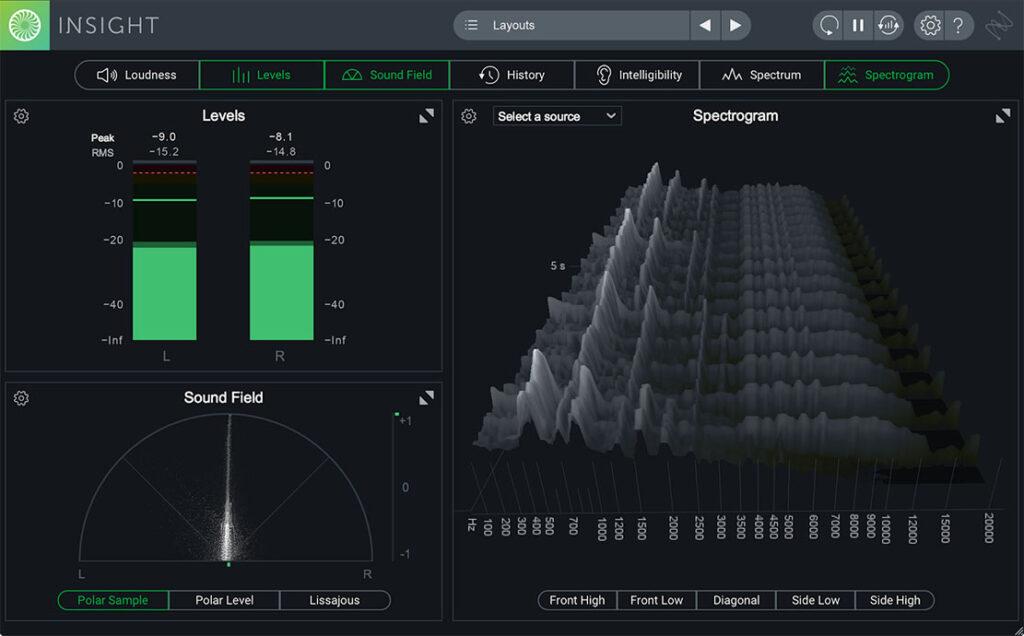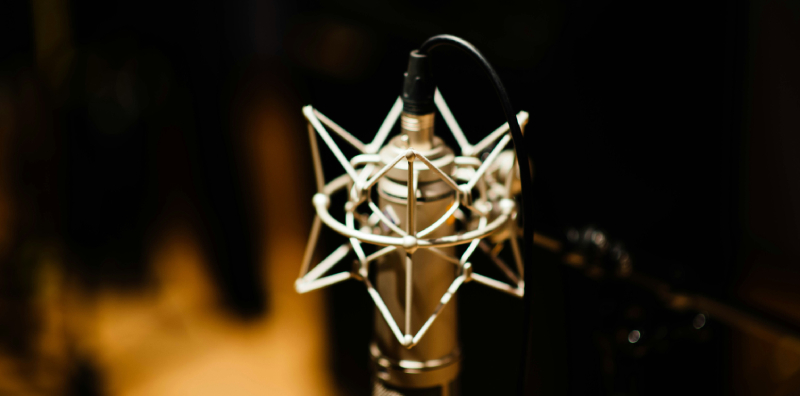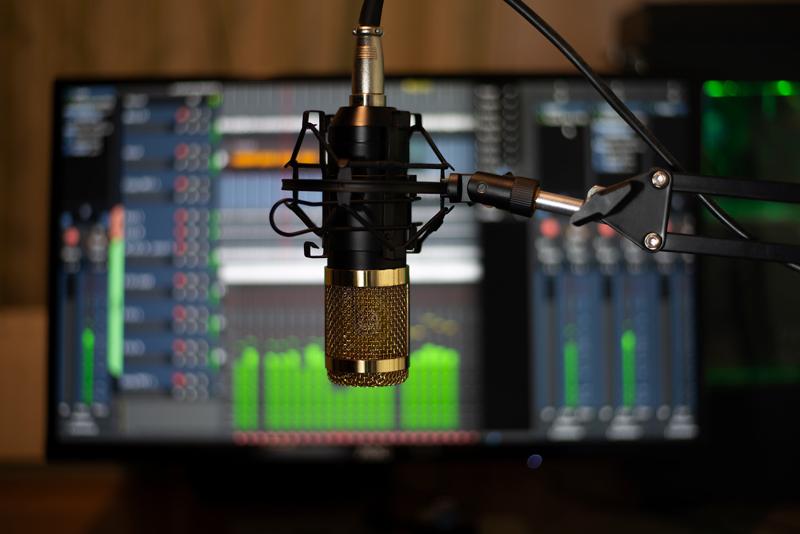RMS for music shows the average loudness of the audio. RMS loudness measures the audio signal taking into account the energy of the wave. This measurement represents the perceived loudness more accurately than peak levels.
In this article we’ll talk about RMS and LUFS metering. What is RMS value for audio, how is it calculated, how to use it, and how is it related to LUFS loudness? Keep reading, we answer these questions in the article.
Average power calculated as RMS power
 RMS is a mathematical term, an abbreviation for Root Mean Square. In simple words it’s a convenient way to calculate some average value in the case when the function can get negative as well as positive, but both negative and positive value represent the same amount of energy we want to measure. This is true particularly for sound waves and for AC electrical current.
RMS is a mathematical term, an abbreviation for Root Mean Square. In simple words it’s a convenient way to calculate some average value in the case when the function can get negative as well as positive, but both negative and positive value represent the same amount of energy we want to measure. This is true particularly for sound waves and for AC electrical current.
In case of such functions, simple mean value calculations wouldn’t work, as summing up positive and negative values will give us zero. So the Root Mean Square calculation of the average is used.
Music production is only one of many applications of the Root Mean Square formula. Root Mean Square is also applied for analyzing electrical current. RMS power, as an example, has to do with power in electrical circuits.
What is RMS value in speakers?
RMS in speakers is RMS watts for speakers, this is related to average power. The parameter shows the maximum electrical power that the speakers can tolerate well during a long period of time, and is related to the power rating, power output of different speakers.
However, we are not getting deep into average power for speakers here, watts, and voltage, and how to use these parameters. Our topic is RMS value for song loudness. We just wanted to emphasize that people use lots of different RMS values, so be careful and don’t mix up these two in particular: RMS loudness and RMS for speakers.
How is RMS calculated for audio?
 As we just said, RMS is one of the average loudness meters. It is calculated as the average loudness of the sound waveform. For the calculations, the Root Mean Square formula is used.
As we just said, RMS is one of the average loudness meters. It is calculated as the average loudness of the sound waveform. For the calculations, the Root Mean Square formula is used.
As opposed to the peak meter, which shows the exact amplitude of a sound wave, RMS meter for the same point takes the average within the time span of 300 ms. That’s how RMS and peak values are different.
Both RMS and Peak metering are in dB FS (decibels relative to full scale)
RMS measurement paints the picture that’s closer to how we perceive loudness than the Peak level values.
Peak metering and perceived loudness
Mastering your song with the correct loudness means everything in today’s music industry. Your music must stand out in a playlist among other compositions. Not only it should be beautiful, interesting, and captivating, first of all, it has to be loud.
Mixing and mastering loud is not as easy a task as it seems. A recording has the maximum level which is 0 dB. Peaks that go higher than the limit untreated will cause clipping which spoils the record.
However, the peak levels do not correspond to the perceived loudness of the record. Short peaks around 20ms we don’t even notice as loud, and they don’t make the music loud for us. On the contrary, the sustain part of the note affects our perception.
This means that, the record with a higher peak level and lower sustain will result in a lower average level and lower loudness for a human ear. Our human perception of how loud the song is relies on average volume that we hear, and RMS levels show it much better than peak metering.
How we use RMS in music production
 RMS gives us a better understanding of the overall loudness of the song, and audio engineers usually monitor RMS. Let’s answer some questions and clarify how RMS is used in mixing and mastering.
RMS gives us a better understanding of the overall loudness of the song, and audio engineers usually monitor RMS. Let’s answer some questions and clarify how RMS is used in mixing and mastering.
Does higher RMS mean better sound?
Higher RMS doesn’t mean that you get a better mix, it doesn’t even mean that you get a louder mix. RMS shows the average power output of the signal, its level.
However, RMS doesn’t take into account how the listener perceives the sound, we can’t measure loudness that the listener will hear with RMS.
For example, if we take high sound that is close to the end of the audible spectrum, close to 20kHz, and increase its volume, the RMS will be jumping high, however, most people will not hear anything.
That’s why RMS is not an accurate representation of perceived loudness.
What is a good RMS level?
The RMS level depends on the song, however, recent songs that have climbed to the top of billboard, show tendency to reach RMS of about -8dB.
How to increase RMS?
If you want higher RMS levels for a song, you can achieve it by lowering the audio dynamic range (or, in other words, lowering Crest factor) and enhancing the volume.
Crest factor is the ratio between the highest peak and the RMS and shows how high the peaks are. Dynamic range also shows how high the peaks of the sound wave are, only it’s measured in decibels (dB) and represent the difference in dB between the loudest and the quietest places in the track.
Audio engineers decrease the dynamic range of a song using different compressor and limiter plugins, while mixing also, but, mostly, at the mastering stage.
Want a free test mix of your track?
We get it.
That’s why we’ll do a full hybrid (analog + digital) mix of your song —
for free.
No upfront payment. No risk.
You only pay if you’re blown away. And if you are, we’ll slash 40% off the final price.
Nobody else in mixing and mastering offers this.
Why?
Because most studios say yes to every project. We don’t. We only mix what we’re excited about — so send us your best track. If we like it, we’ll mix it like it’s going to the Grammys.
👉 Just drop your name and email to get started.
How do I check RMS levels?
There are many different plugins you can use for monitoring loudness of a song. Your DAW may include a stock plugin like, for example, you can use a standard RMS meter in Cubase.
Of course, there are many plugins with this function. To name a few, there is TT Dynamic Range meter, iZotope insight plugin, Ozone 9,

FabFilter Pro-Q 3, and many others.
Should I use LUFS or RMS?
Even though Root Mean Square gives us a pretty good idea of what is the average loudness of the track, there is more accurate measurement regarding human ear, and it is LUFS (Loudness Units relative to Full Scale). Remember that RMS metering works with power of a signal. The main difference is that LUFS takes into account other factors as well, and most importantly, how a human ear hears music.
Simply put, LUFS metering uses a human hearing curve, where high frequencies typically seem louder than low frequencies of the same volume. That’s why LUFS represents the perceived volume much better than RMS, moreover much better than peak levels.
This means that the dark song with a lot of low frequencies can show for example -5dB RMS, while the LUFS meter will drop as low as -14LUFS integrated loudness. And you can get the opposite result with a mix that’s too bright.
In the term “LUFS integrated loudness”, the word “integrated” means “for the whole song”. However, both RMS and LUFS can be called integrated meters in the sense that they represent the average value for a certain period of time. When this period of time is the composition as a whole, the parameters are called integrated, while done for a certain timepoint in a song they are called “momentary” and for calculations the algorythms use a tiny time window (usually 300ms for RMS and 400ms for LUFS).
LUFS is the most important measurement on which mastering engineers rely while creating the final product – a master record for release, because LUFS is used to set the loudness level on streaming platforms.
However, a good audio engineer pays attention to all the parameters while working on a song: RMS, LUFS, Peak and True peak values and others.
The important thing to remember is that usually, when engineers work with records, they use not one but several plugins to check the loudness. This happens because each plugin may show a slightly different results for RMS and LUFS depending on its algorithm and settings. So it is useful to check the loudness using different plugins.
Move with the masters
Now, as we answered your questions about RMS, we’d like to remind you that nothing but the highest quality of sound can gain popularity in the music world today. And if you wish to give your songs the best shot releasing them into the world, you need your mixing and mastering to be done professionally.
We have been preparing music for release professionally for more than a decade, and still treat each song as a special one, the winner. We’ll give your future hit captivating and striking sound with our high-quality mixing and mastering.
Contact us if you need to boost your career in the music world, we’ll be happy to help you do so!










